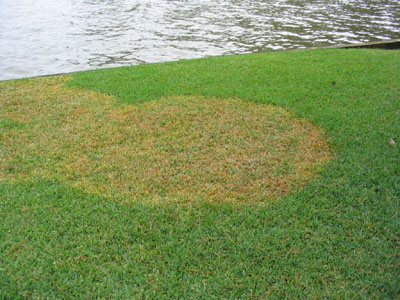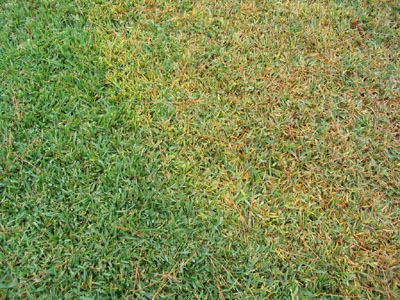





You have brown patches of dead grass in your lawn. Is it the common lawn disease ‘brown patch’ or is it something else? The answer is important: if it is brown patch you probably need to spray with a fungicide. If it is not, you’ll waste your money buying expensive chemicals.
DISEASE vs ENVIRONMENT While brown patch does cause patches of dead grass, other things can cause the (U)same(/U) symptoms. If the area is poorly drained and water stands on a spot for more than 24 hours, the grass roots will rot, causing a dead patch. If you have a sodded lawn less than one year old, it is possible the soil underneath the sod was never plowed to relieve compaction. Where the sod has rooted poorly, brown patches will develop as dry weather sets in. If one part of the lawn was once used as a baseball home plate or a soccer goalie area, the earth beneath is almost as hard as concrete. It’s easy to see why green grass would turn brown there.
BROWN PATCH SYMPTOMS If you eliminate environmental causes of the brown patch, what are the true symptoms of the disease? True brown patch spots are small to begin with but in warm weather they can enlarge rapidly. Seen from above, the patch will look like a doughnut – a ring of tan grass having a patch of green grass in the center. Individual grass blades will be brown down to the crown – where the blade emerges from the ground – but the crown will be green. Early in the morning during hot, damp weather you might see a white fungal web at the edge of the dead grass patch.
KEEP GRASS HEALTHY Remember that the fungus that causes brown patch is constantly present. It can not be eliminated. Your grass gets sick because it is weak and becomes susceptible to the disease. You can help keep the grass strong by fertilizing only when the grass needs it: during the cool months for fescue and during the warm months for bermudagrass.
WATERING Never water in the evening. The best time to water is in early morning. Fescue is much more susceptible when it has lush, green growth plus warm nighttime temperatures. Warmth at night can not be avoided but lush growth can be moderated. The second step is to water at the right time. Since brown patch needs 14-16 hours of wet leaf surface to reproduce itself, water only after the dew has dried in the morning. An alternative is to water after nightfall. Since the grass is wet with dew anyway, watering in the dark does not unnecessarily extend the wet period.
FERTILIZER Fertilizer applied in late spring and summer causes rapid growth (which must be mowed!) and drought stress. It is best to fertilize fescue only in fall, winter and spring. Dr. Lee Burpee, at the Griffin Experiment Station, reports that nitrogen fertilizer in June, July and August increased the severity of brown patch fungus on all cultivars tested except Kentucky 31 fescue. He also found that the disease was worse at mowing heights less than two inches and more that three inches. Fungicides to control brown patch are available but they must be applied regularly. To avoid the expense, change the cultural conditions before reaching for the fungicide.
FUNGICIDES If you are absolutely sure you have brown patch, the disease can be controlled with fungicides. Several are labeled for brown patch control. Although they are effective, their cost may cause you to reconsider their use. Curing brown patch in a lawn may require an application of fungicide every 14 days. A lawn fungicide costs approximately $20 per 1000 square feet per application. For a typical 5,000 square foot lawn, that comes to $100 every two weeks. Let your pocketbook be your guide!
POSITIVE IDENTIFICATION Obviously, it would be nice to have a positive identification of a disease before you decide on the best course of action. You can get that positive ID from your local Extension office (1-800-ASKUGA1). Bring them a sample of your sick grass; it will be sent, for a nominal charge, to the state disease lab for identification and treatment recommendations.
LAWN DISEASE ID SAMPLING If you suspect that you may have a turfgrass disease, your sampling procedure is critical in order to get an accurate diagnosis. Go to the suspected disease area. Find where the live grass meets some dead grass. This is called the disease margin area. You need to cut a 4 x 4 inch square that has half dead grass and half live grass in it. Include the roots. Do not allow the sample to heat, do not allow the sample to dry out. Place in a paper bag or plastic bag which is not sealed. If you cannot bring the sample in the same day you cut it, it is best to refrigerate it. Take it to your local county Extension office (1-800-ASKUGA-1). They would prefer to get the sample on Monday or Tuesday so that they can mail it to the plant disease lab without any delay in the mail. Results will be mailed to you in about 10 days.
Evaluation of Fungicides for Brown Patch Control


Copyright © www.100flowers.win Botanic Garden All Rights Reserved